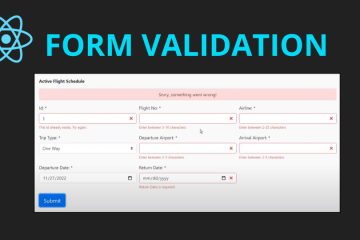How to Access URL Parameters Using React Router 6
November 27, 2021
React Router version 6 introduces several powerful new features, as well as improved compatibility with the latest versions of React. It also introduces a few breaking changes from version 5. This document is a comprehensive guide on how to upgrade your v4/5 app to v6 while hopefully being able to ship as often as possible as you go.
https://reactrouterdotcom.fly.dev/docs/en/v6/upgrading/v5
To learn more about all the new changes and how to upgrade to version 6, please visit https://reactrouterdotcom.fly.dev/docs/en/v6/upgrading/v5
Below are two examples of changes that you will need to adhere to if you’re running version 6.
- React Router v6 introduces a
Routescomponent that replacesSwitch. In order to use v6, you’ll need to convert all your<Switch>elements to<Routes>. - React Router v6 introduces an
elementproperty that replaces therenderproperty/function. Thus passing URL parameters to class components is a little different. There are no changes to function components.
1️⃣ How to Retrieve URL Parameters Using Function Components
Below is one common and easy way to create react routes.
index.js
First, let’s wrap the root component with the BrowserRouter.
import React from 'react';
import ReactDOM from 'react-dom';
import { BrowserRouter as Router } from 'react-router-dom';
import './index.css';
import App from './App';
import * as serviceWorker from './serviceWorker';
ReactDOM.render(
<Router>
<App />
</Router>
, document.getElementById('root'));
serviceWorker.unregister();App.js Component
In the App.js module, let’s create a route to the /flights/:id url. The FlightList component is a Function Component to display information about a single flight record. In order to do that, we’ll need to fetch the id parameter from the URL.
import React from 'react';
import { Routes, Route} from 'react-router-dom';
import { Nav, Footer, FlighData, FlightList } from "./components";
import './App.css';
class App extends React.Component {
constructor(props) {
super(props);
this.state = { flightData: FlighData };
}
render() {
return (
<div className="App">
<Nav />
<Routes>
<Route path="/flights/:id" element={<FlightList flightData={this.state.flightData} />} />
</Routes>
<Footer />
</div>
);
}
}
export default App;
FlightList.js Component
In the FlightList component, retrieve the id URL parameter via the useParams() function. After the id is obtained, search the flightData list and retrieve the flight record matching the id.
import React from 'react';
import { useParams } from 'react-router-dom';
export function FlightList(props) {
let { id } = useParams(); // Unpacking and retrieve id
let index = props.flightData.findIndex(e => e.id === parseInt(id));
let flight = this.props.flightData[index];
return (
<div>
<p>Flight Number: {flight.flight_no}</p>
<p>Airline: {flight.airline}</p>
<p>Departure Airport: {flight.departure_airport}</p>
<p>Arrival Airport: {flight.arrival_airport}</p>
<p>Depart Date: {flight.departure_date}</p>
<p>Arrival Date: {flight.arrival_airport}</p>
</div>
)
}
2️⃣ How to Retrieve URL Parameters Using Class Components
Class Components do not have access to Hooks so they cannot use useParams() from the react router. Of course there are other methods to pass data down to child components (e.g. using Context). The example demonstrated here is how to use a Wrapper function component to pass the params via the match property to a Class Component. Finally, it’ll be possible to retrieve specific parameters from the params via the props object.
App.js Component
In the App.js module, let’s create a route to the /edit/:id url. The EditFlight component is a Class Component to edit an existing flight record. In order to do that, we’ll need to fetch the id parameter from the URL.
import React from 'react';
import { Routes, Route, useParams } from 'react-router-dom';
import { Nav, Footer, FlighData, EditFlight } from "./components";
import './App.css';
class App extends React.Component {
constructor(props) {
super(props);
this.state = { flightData: FlighData };
this.updateFlight = this.updateFlight.bind(this);
}
updateFlight(idx, flight) {
let temp = this.state.flightData;
temp[idx] = flight;
this.setState({ flightData: temp })
}
render() {
const Wrapper = (props) => {
const params = useParams();
return <EditFlight flightData={this.state.flightData} updateFlight={this.updateFlight} {...{...props, match: {params}} } />
}
return (
<div className="App">
<Nav />
<Routes>
<Route path="/edit/:id" element={<Wrapper />} />
</Routes>
<Footer />
</div>
);
}
}
export default App;
EditFlight.js Component
In the EditFlight component, retrieve the id from the URL parameters via the props object. After the id is obtained, search the flightData list and retrieve the flight record matching the id. Finally, pass this record to another child component FlightForm to populate the form for editing.
import React from 'react';
import FlightForm from './FlightForm';
export class EditFlight extends React.Component {
constructor(props) {
super(props);
}
render() {
console.log(this.props)
let { id } = this.props.match.params; // Unpacking and retrieve id
let index = this.props.flightData.findIndex(e => e.id === parseInt(id)); // Get the index of matching record
let flight = this.props.flightData[index]; // Get the record
return <FlightForm flight={flight} handleChange={this.handleChange} handleSubmit={this.handleSubmit} />
}
handleChange(event) {
// Implemenation here
}
handleSubmit(event) {
event.preventDefault();
// Implementation here
}
}
See live sample here.



